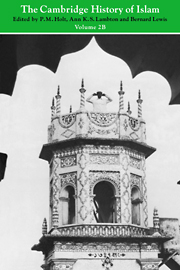Book contents
- Frontmatter
- Introduction
- PART VIII ISLAMIC SOCIETY AND CIVILIZATION
- 1 THE GEOGRAPHICAL SETTING
- 2 THE SOURCES OF ISLAMIC CIVILIZATION
- 3 ECONOMY, SOCIETY, INSTITUTIONS
- 4 LAW AND JUSTICE
- 5 RELIGION AND CULTURE
- 6 MYSTICISM
- 7 REVIVAL AND REFORM IN ISLAM
- 8 LITERATURE
- (a) ARABIC LITERATURE
- (b) PERSIAN LITERATURE
- (c) TURKISH LITERATURE
- (d) URDU LITERATURE
- 9 ART AND ARCHITECTURE
- 10 SCIENCE
- 11 PHILOSOPHY
- 12 WARFARE
- 13 THE TRANSMISSION OF LEARNING AND LITERARY INFLUENCES TO WESTERN EUROPEo
- Dynastic List
- Bibliography
- Glossary
- Index
- References
(c) - TURKISH LITERATURE
from 8 - LITERATURE
Published online by Cambridge University Press: 28 March 2008
- Frontmatter
- Introduction
- PART VIII ISLAMIC SOCIETY AND CIVILIZATION
- 1 THE GEOGRAPHICAL SETTING
- 2 THE SOURCES OF ISLAMIC CIVILIZATION
- 3 ECONOMY, SOCIETY, INSTITUTIONS
- 4 LAW AND JUSTICE
- 5 RELIGION AND CULTURE
- 6 MYSTICISM
- 7 REVIVAL AND REFORM IN ISLAM
- 8 LITERATURE
- (a) ARABIC LITERATURE
- (b) PERSIAN LITERATURE
- (c) TURKISH LITERATURE
- (d) URDU LITERATURE
- 9 ART AND ARCHITECTURE
- 10 SCIENCE
- 11 PHILOSOPHY
- 12 WARFARE
- 13 THE TRANSMISSION OF LEARNING AND LITERARY INFLUENCES TO WESTERN EUROPEo
- Dynastic List
- Bibliography
- Glossary
- Index
- References
Summary
Following the general trend and development of Turkish cultural history, it is possible to divide Turkish literature into four main periods:
The literature of the Turks before they accepted Islam (from the origins to the eleventh century).
Islamic Turkish literature (from the eleventh century to the middle of the nineteenth century).
Turkish literature under Western influence (1850–1910).
National and local literature (since 1910).
The first products of the old Turkish literature have not reached our times. We only have Chinese translations of the first examples of epics and lyrics. The extant products of the earliest written literature fall into two main groups. One of these consists of the inscriptions in north-east Asia. The most representative of these which are written in an alphabet developed from Aramaic through Sogdian, not deciphered until the end of the nineteenth century, are the Orhon inscriptions. They are known by this name because they were discovered near the Orhon river, a branch of the Selenga which flows into Lake Baykal. They were erected for Prince Kül (or Köl) and Bilge Khan (d. 731 and 734 respectively) of the Kök-Türk dynasty which flourished between the sixth and eighth Christian centuries. They relate the history of the Kök-Türks, their surrender to the Chinese and liberation under the guidance of Bilge Khan. The Turkish of the inscriptions gives the impression of a mature language and its lively style has in various places an exciting and epic atmosphere.
- Type
- Chapter
- Information
- The Cambridge History of Islam , pp. 682 - 694Publisher: Cambridge University PressPrint publication year: 1977



